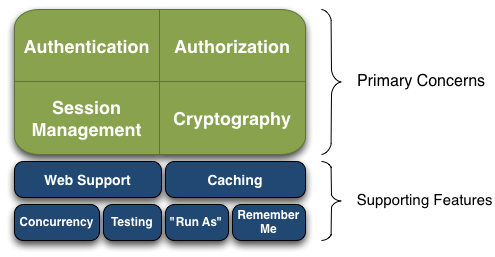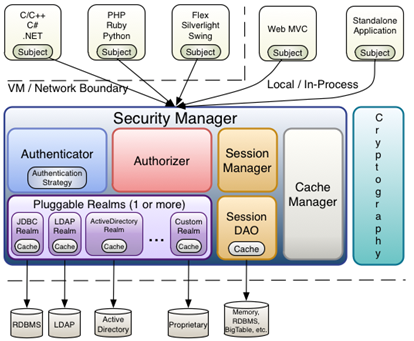Shrio第一天——入门与基本概述
一、Shiro是什么
Apache Shiro是Java的一个安全框架。(希罗:/笑哭)
Shiro可以非常容易的开发出足够好的应用,其不仅可以用在JavaSE环境,也可以用在JavaEE环境。
shiro官网:http://shiro.apache.org/
why shiro:
spring中有spring security (原名Acegi),是一个权限框架,它和spring依赖过于紧密,没有shiro使用简单。
Shiro在保持强大功能的同时,还在简单性和灵活性方面拥有巨大优势.简言之:简单,强大!
shiro不依赖于spring,shiro不仅可以实现 web应用的权限管理,还可以实现c/s系统,分布式系统权限管理,shiro属于轻量框架,越来越多企业项目开始使用shiro。
Shiro可以帮助我们完成:认证、授权、加密、会话管理、与Web集成、缓存等。
Shiro的结构:

二、Shiro的架构
对于一个好的框架,从外部来看应该具有非常简单易于使用的API,且API契约明确;从内部来看的话,其应该有一个可扩展的架构,即非常容易插入用户自定义实现,因为任何框架都不能满足所有需求。
外部架构:

可以看到:应用代码直接交互的对象是Subject,也就是说Shiro的对外API核心就是Subject;其每个API的含义:
Subject:主体,代表了当前“用户”,这个用户不一定是一个具体的人,与当前应用交互的任何东西都是Subject,如网络爬虫,机器人等;即一个抽象概念;所有Subject都绑定到SecurityManager,与Subject的所有交互都会委托给SecurityManager;可以把Subject认为是一个门面;SecurityManager才是实际的执行者;
SecurityManager:安全管理器;即所有与安全有关的操作都会与SecurityManager交互;且它管理着所有Subject;可以看出它是Shiro的核心,它负责与后边介绍的其他组件进行交互,如果学习过SpringMVC,你可以把它看成DispatcherServlet前端控制器;
Realm:域,Shiro从从Realm获取安全数据(如用户、角色、权限),就是说SecurityManager要验证用户身份,那么它需要从Realm获取相应的用户进行比较以确定用户身份是否合法;也需要从Realm得到用户相应的角色/权限进行验证用户是否能进行操作;可以把Realm看成DataSource,即安全数据源。可以说,Realm是专用于安全框架的DAO.
内部架构:

Subject:主体,可以看到主体可以是任何可以与应用交互的“用户”;
SecurityManager:相当于SpringMVC中的DispatcherServlet或者Struts2中的FilterDispatcher;是Shiro的心脏;所有具体的交互都通过SecurityManager进行控制;它管理着所有Subject、且负责进行认证和授权、及会话、缓存的管理。
Authenticator:认证器,负责主体认证的,这是一个扩展点,如果用户觉得Shiro默认的不好,可以自定义实现;其需要认证策略(Authentication Strategy),即什么情况下算用户认证通过了;
Authrizer:授权器,或者访问控制器,用来决定主体是否有权限进行相应的操作;即控制着用户能访问应用中的哪些功能;
Realm:可以有1个或多个Realm,可以认为是安全实体数据源,即用于获取安全实体的;可以是JDBC实现,也可以是LDAP实现,或者内存实现等等;由用户提供;注意:Shiro不知道你的用户/权限存储在哪及以何种格式存储;所以我们一般在应用中都需要实现自己的Realm;
SessionManager:如果写过Servlet就应该知道Session的概念,Session呢需要有人去管理它的生命周期,这个组件就是SessionManager;而Shiro并不仅仅可以用在Web环境,也可以用在如普通的JavaSE环境、EJB等环境;所有呢,Shiro就抽象了一个自己的Session来管理主体与应用之间交互的数据;这样的话,比如我们在Web环境用,刚开始是一台Web服务器;接着又上了台EJB服务器;这时想把两台服务器的会话数据放到一个地方,这个时候就可以实现自己的分布式会话(如把数据放到Memcached服务器);此特性可使它实现单点登录。
SessionDAO:DAO大家都用过,数据访问对象,用于会话的CRUD,比如我们想把Session保存到数据库,那么可以实现自己的SessionDAO,通过如JDBC写到数据库;比如想把Session放到Memcached中,可以实现自己的Memcached SessionDAO;另外SessionDAO中可以使用Cache进行缓存,以提高性能;
CacheManager:缓存控制器,来管理如用户、角色、权限等的缓存的;因为这些数据基本上很少去改变,放到缓存中后可以提高访问的性能(对session进行缓存等)
Cryptography:密码模块,Shiro提高了一些常见的加密组件用于如密码加密/解密的。
三、shiro的HelloWorld
1.加入依赖

<!-- 版本信息 --> <properties> <shiro.version>1.3.2</shiro.version> </properties> <dependencies> <!-- shiro --> <dependency> <groupId>org.apache.shiro</groupId> <artifactId>shiro-core</artifactId> <version>${shiro.version}</version> </dependency> <dependency> <groupId>org.apache.shiro</groupId> <artifactId>shiro-web</artifactId> <version>${shiro.version}</version> </dependency> <dependency> <groupId>org.apache.shiro</groupId> <artifactId>shiro-spring</artifactId> <version>${shiro.version}</version> </dependency> <!-- https://mvnrepository.com/artifact/org.slf4j/slf4j-log4j12 --> <dependency> <groupId>org.slf4j</groupId> <artifactId>slf4j-log4j12</artifactId> <version>1.6.1</version> <scope>test</scope> </dependency> </dependencies>
2.加入官方quick start的配置文件
log4j.properties:

#
# Licensed to the Apache Software Foundation (ASF) under one
# or more contributor license agreements. See the NOTICE file
# distributed with this work for additional information
# regarding copyright ownership. The ASF licenses this file
# to you under the Apache License, Version 2.0 (the
# "License"); you may not use this file except in compliance
# with the License. You may obtain a copy of the License at
#
# http://www.apache.org/licenses/LICENSE-2.0
#
# Unless required by applicable law or agreed to in writing,
# software distributed under the License is distributed on an
# "AS IS" BASIS, WITHOUT WARRANTIES OR CONDITIONS OF ANY
# KIND, either express or implied. See the License for the
# specific language governing permissions and limitations
# under the License.
#
log4j.rootLogger=INFO, stdout
log4j.appender.stdout=org.apache.log4j.ConsoleAppender
log4j.appender.stdout.layout=org.apache.log4j.PatternLayout
log4j.appender.stdout.layout.ConversionPattern=%d %p [%c] - %m %n
# General Apache libraries
log4j.logger.org.apache=WARN
# Spring
log4j.logger.org.springframework=WARN
# Default Shiro logging
log4j.logger.org.apache.shiro=TRACE
# Disable verbose logging
log4j.logger.org.apache.shiro.util.ThreadContext=WARN
log4j.logger.org.apache.shiro.cache.ehcache.EhCache=WARN
shiro.ini:——身份凭据数据

#
# Licensed to the Apache Software Foundation (ASF) under one
# or more contributor license agreements. See the NOTICE file
# distributed with this work for additional information
# regarding copyright ownership. The ASF licenses this file
# to you under the Apache License, Version 2.0 (the
# "License"); you may not use this file except in compliance
# with the License. You may obtain a copy of the License at
#
# http://www.apache.org/licenses/LICENSE-2.0
#
# Unless required by applicable law or agreed to in writing,
# software distributed under the License is distributed on an
# "AS IS" BASIS, WITHOUT WARRANTIES OR CONDITIONS OF ANY
# KIND, either express or implied. See the License for the
# specific language governing permissions and limitations
# under the License.
#
# =============================================================================
# Quickstart INI Realm configuration
#
# For those that might not understand the references in this file, the
# definitions are all based on the classic Mel Brooks' film "Spaceballs". ;)
# =============================================================================
# -----------------------------------------------------------------------------
# Users and their assigned roles
#
# Each line conforms to the format defined in the
# org.apache.shiro.realm.text.TextConfigurationRealm#setUserDefinitions JavaDoc
# -----------------------------------------------------------------------------
[users]
# user 'root' with password 'secret' and the 'admin' role
root = secret, admin
# user 'guest' with the password 'guest' and the 'guest' role
guest = guest, guest
# user 'presidentskroob' with password '12345' ("That's the same combination on
# my luggage!!!" ;)), and role 'president'
presidentskroob = 12345, president
# user 'darkhelmet' with password 'ludicrousspeed' and roles 'darklord' and 'schwartz'
darkhelmet = ludicrousspeed, darklord, schwartz
# user 'lonestarr' with password 'vespa' and roles 'goodguy' and 'schwartz'
lonestarr = vespa, goodguy, schwartz
# -----------------------------------------------------------------------------
# Roles with assigned permissions
#
# Each line conforms to the format defined in the
# org.apache.shiro.realm.text.TextConfigurationRealm#setRoleDefinitions JavaDoc
# -----------------------------------------------------------------------------
[roles]
# 'admin' role has all permissions, indicated by the wildcard '*'
admin = *
# The 'schwartz' role can do anything (*) with any lightsaber:
schwartz = lightsaber:*
# The 'goodguy' role is allowed to 'delete' (action) the user (type) with
# license plate 'zhangsan' (instance specific id)
goodguy = user:delete:zhangsan
3.引入quickstart.java文件:

package cn.shiro.helloworld; import org.apache.shiro.SecurityUtils; import org.apache.shiro.authc.*; import org.apache.shiro.config.IniSecurityManagerFactory; import org.apache.shiro.mgt.SecurityManager; import org.apache.shiro.session.Session; import org.apache.shiro.subject.Subject; import org.apache.shiro.util.Factory; import org.slf4j.Logger; import org.slf4j.LoggerFactory; /** * Simple Quickstart application showing how to use Shiro's API. * * @since 0.9 RC2 */ public class Quickstart { private static final transient Logger log = LoggerFactory.getLogger(Quickstart.class); public static void main(String[] args) { // The easiest way to create a Shiro SecurityManager with configured // realms, users, roles and permissions is to use the simple INI config. // We'll do that by using a factory that can ingest a .ini file and // return a SecurityManager instance: // Use the shiro.ini file at the root of the classpath // (file: and url: prefixes load from files and urls respectively): Factory<SecurityManager> factory = new IniSecurityManagerFactory("classpath:shiro.ini"); SecurityManager securityManager = factory.getInstance(); // for this simple example quickstart, make the SecurityManager // accessible as a JVM singleton. Most applications wouldn't do this // and instead rely on their container configuration or web.xml for // webapps. That is outside the scope of this simple quickstart, so // we'll just do the bare minimum so you can continue to get a feel // for things. SecurityUtils.setSecurityManager(securityManager); // Now that a simple Shiro environment is set up, let's see what you can do: // get the currently executing user: // ��ȡ��ǰ�� Subject. ���� SecurityUtils.getSubject(); Subject currentUser = SecurityUtils.getSubject(); // Do some stuff with a Session (no need for a web or EJB container!!!) // ����ʹ�� Session // ��ȡ Session: Subject#getSession() Session session = currentUser.getSession(); session.setAttribute("someKey", "aValue"); String value = (String) session.getAttribute("someKey"); if (value.equals("aValue")) { log.info("---> Retrieved the correct value! [" + value + "]"); } // let's login the current user so we can check against roles and permissions: // ���Ե�ǰ���û��Ƿ��Ѿ�����֤. ���Ƿ��Ѿ���¼. // ���� Subject �� isAuthenticated() if (!currentUser.isAuthenticated()) { // ���û����������װΪ UsernamePasswordToken ���� UsernamePasswordToken token = new UsernamePasswordToken("lonestarr", "vespa"); // rememberme token.setRememberMe(true); try { // ִ�е�¼. currentUser.login(token); } // ��û��ָ�����˻�, �� shiro �����׳� UnknownAccountException �쳣. catch (UnknownAccountException uae) { log.info("----> There is no user with username of " + token.getPrincipal()); return; } // ���˻�����, �����벻ƥ��, �� shiro ���׳� IncorrectCredentialsException �쳣�� catch (IncorrectCredentialsException ice) { log.info("----> Password for account " + token.getPrincipal() + " was incorrect!"); return; } // �û����������쳣 LockedAccountException catch (LockedAccountException lae) { log.info("The account for username " + token.getPrincipal() + " is locked. " + "Please contact your administrator to unlock it."); } // ... catch more exceptions here (maybe custom ones specific to your application? // ������֤ʱ�쳣�ĸ���. catch (AuthenticationException ae) { //unexpected condition? error? } } //say who they are: //print their identifying principal (in this case, a username): log.info("----> User [" + currentUser.getPrincipal() + "] logged in successfully."); //test a role: // �����Ƿ���ijһ����ɫ. ���� Subject �� hasRole ����. if (currentUser.hasRole("schwartz")) { log.info("----> May the Schwartz be with you!"); } else { log.info("----> Hello, mere mortal."); return; } //test a typed permission (not instance-level) // �����û��Ƿ�߱�ijһ����Ϊ. ���� Subject �� isPermitted() ������ if (currentUser.isPermitted("lightsaber:weild")) { log.info("----> You may use a lightsaber ring. Use it wisely."); } else { log.info("Sorry, lightsaber rings are for schwartz masters only."); } //a (very powerful) Instance Level permission: // �����û��Ƿ�߱�ijһ����Ϊ. if (currentUser.isPermitted("user:delete:zhangsan")) { log.info("----> You are permitted to 'drive' the winnebago with license plate (id) 'eagle5'. " + "Here are the keys - have fun!"); } else { log.info("Sorry, you aren't allowed to drive the 'eagle5' winnebago!"); } //all done - log out! // ִ�еdz�. ���� Subject �� Logout() ����. System.out.println("---->" + currentUser.isAuthenticated()); currentUser.logout(); System.out.println("---->" + currentUser.isAuthenticated()); System.exit(0); } }
//中文乱码有待解决
这里存在的问题是用户名密码直接写在ini配置文件中,难以管理,密码也不应该明文存储。这里后文会陆续有解决方案。
入门程序大致流程分析:
1、通过ini配置文件创建securityManager
2、调用subject.login方法主体提交认证,提交的token
3、securityManager进行认证,securityManager最终由ModularRealmAuthenticator进行认证。
4、ModularRealmAuthenticator调用IniRealm(给realm传入token) 去ini配置文件中查询用户信息
5、IniRealm根据输入的token(UsernamePasswordToken)从 shiro-first.ini查询用户信息,根据账号查询用户信息(账号和密码)
如果查询到用户信息,就给ModularRealmAuthenticator返回用户信息(账号和密码)
如果查询不到,就给ModularRealmAuthenticator返回null
6、ModularRealmAuthenticator接收IniRealm返回Authentication认证信息
如果返回的认证信息是null,ModularRealmAuthenticator抛出异常(org.apache.shiro.authc.UnknownAccountException)
如果返回的认证信息不是null(说明inirealm找到了用户),对IniRealm返回用户密码 (在ini文件中存在)和 token中的密码 进行对比,如果不一致抛出异常(org.apache.shiro.authc.IncorrectCredentialsException)
3.自定义Realm
通常自定义的realm继承AuthorizingRealm(重写认证和授权方法)。Realm的调用流程见上文

public class CustomRealm extends AuthorizingRealm { // 设置realm的名称 @Override public void setName(String name) { super.setName("customRealm"); } // 用于认证 @Override protected AuthenticationInfo doGetAuthenticationInfo( AuthenticationToken token) throws AuthenticationException { // token是用户输入的 // 第一步从token中取出身份信息 String userCode = (String) token.getPrincipal(); // 第二步:根据用户输入的userCode从数据库查询 // .... // 如果查询不到返回null //数据库中用户账号是zhangsansan /*if(!userCode.equals("zhangsansan")){// return null; }*/ // 模拟从数据库查询到密码 String password = "111112"; // 如果查询到返回认证信息AuthenticationInfo SimpleAuthenticationInfo simpleAuthenticationInfo = new SimpleAuthenticationInfo( userCode, password, this.getName()); return simpleAuthenticationInfo; } // 用于授权 @Override protected AuthorizationInfo doGetAuthorizationInfo( PrincipalCollection principals) { // TODO Auto-generated method stub return null; } }
//认证信息:AuthenticationInfo authcInfo = new SimpleAuthenticationInfo(shop.getLoginName(), shop.getPassword(), "昵称或真实姓名");
当然,认证信息有其它重载构造器,视情况更换。
再将自定义的Realm进行配置(不然shiro怎么知道要用你的Realm呢):后面spring的注入原理类似,只是方式不同
[main]
#\u81ea\u5b9a\u4e49 realm
customRealm=cn.itcast.shiro.realm.CustomRealm
#\u5c06realm\u8bbe\u7f6e\u5230securityManager\uff0c\u76f8\u5f53 \u4e8espring\u4e2d\u6ce8\u5165
securityManager.realms=$customRealm
4.散列算法
在程序中对原始密码+盐进行散列,将散列值存储到数据库中,并且还要将盐也要存储在数据库中。
如果进行密码对比时,使用相同 方法,将原始密码+盐进行散列,进行比对。
md5散列程序:

public static void main(String[] args) { //原始 密码 String source = "111111"; //盐 String salt = "qwerty"; //散列次数 int hashIterations = 2; //上边散列1次:f3694f162729b7d0254c6e40260bf15c //上边散列2次:36f2dfa24d0a9fa97276abbe13e596fc //构造方法中: //第一个参数:明文,原始密码 //第二个参数:盐,通过使用随机数 //第三个参数:散列的次数,比如散列两次,相当 于md5(md5('')) Md5Hash md5Hash = new Md5Hash(source, salt, hashIterations); String password_md5 = md5Hash.toString(); System.out.println(password_md5); //第一个参数:散列算法 SimpleHash simpleHash = new SimpleHash("md5", source, salt, hashIterations); System.out.println(simpleHash.toString()); }
将realm与散列集成,使得自定义realm支持散列算法:

public class CustomRealmMd5 extends AuthorizingRealm { // 设置realm的名称 @Override public void setName(String name) { super.setName("customRealmMd5"); } // 用于认证 @Override protected AuthenticationInfo doGetAuthenticationInfo( AuthenticationToken token) throws AuthenticationException { // token是用户输入的 // 第一步从token中取出身份信息 String userCode = (String) token.getPrincipal(); // 第二步:根据用户输入的userCode从数据库查询 // .... // 如果查询不到返回null // 数据库中用户账号是zhangsansan /* * if(!userCode.equals("zhangsansan")){// return null; } */ // 模拟从数据库查询到密码,散列值 String password = "f3694f162729b7d0254c6e40260bf15c"; // 从数据库获取salt String salt = "qwerty"; //上边散列值和盐对应的明文:111111 // 如果查询到返回认证信息AuthenticationInfo SimpleAuthenticationInfo simpleAuthenticationInfo = new SimpleAuthenticationInfo( userCode, password, ByteSource.Util.bytes(salt), this.getName()); return simpleAuthenticationInfo; } // 用于授权 @Override protected AuthorizationInfo doGetAuthorizationInfo( PrincipalCollection principals) { // TODO Auto-generated method stub return null; }
配置凭证匹配器(散列算法与散列次数):

[main] #\u5b9a\u4e49\u51ed\u8bc1\u5339\u914d\u5668 credentialsMatcher=org.apache.shiro.authc.credential.HashedCredentialsMatcher #\u6563\u5217\u7b97\u6cd5 credentialsMatcher.hashAlgorithmName=md5 #\u6563\u5217\u6b21\u6570 credentialsMatcher.hashIterations=1 #\u5c06\u51ed\u8bc1\u5339\u914d\u5668\u8bbe\u7f6e\u5230realm customRealm=cn.itcast.shiro.realm.CustomRealmMd5 customRealm.credentialsMatcher=$credentialsMatcher securityManager.realms=$customRealm
四、与sprng的集成
(请参见官方文档:http://shiro.apache.org/spring.html)
完整与SSM整合已抽取为一篇博文(陆续更新补充):http://www.cnblogs.com/jiangbei/p/7221565.html
五、基本工作原理
我们简单了解下大致的工作流程:

其中,DelegatingFilterProxy 作用是自动到 Spring 容器查找名 字为 shiroFilter(filter-name)的 bean 并把所有 Filter 的操作委托给它。
所以,web.xml中DelegatingFilterProxy的filter-name必须和spring配置文件中bean的id一致(否则加载就会报错,可以查看相关的spring的源码注释),若要自定义,请在filter中定义init-param定义targerBeanName!
当然,可以在filterChainDefinitions配置需要认证的页面!接下来来看如何配置受保护的URL(spring中的第六步):
[urls] 部分的配置,其格式是: “url=拦截器[参数],拦截 器[参数]”;
例如前面的配置(此处暂时未配置参数)
<property name="filterChainDefinitions">
<value>
/login.jsp = anon
# everything else requires authentication:
/** = authc
</value>
</property>
所有默认的过滤器:(可以通过defaultFilter枚举类来查看)
public enum DefaultFilter { anon(AnonymousFilter.class), authc(FormAuthenticationFilter.class), authcBasic(BasicHttpAuthenticationFilter.class), logout(LogoutFilter.class), noSessionCreation(NoSessionCreationFilter.class), perms(PermissionsAuthorizationFilter.class), port(PortFilter.class), rest(HttpMethodPermissionFilter.class), roles(RolesAuthorizationFilter.class), ssl(SslFilter.class), user(UserFilter.class); }
| anon | org.apache.shiro.web.filter.authc.AnonymousFilter |
| authc | org.apache.shiro.web.filter.authc.FormAuthenticationFilter |
| authcBasic | org.apache.shiro.web.filter.authc.BasicHttpAuthenticationFilter |
| perms | org.apache.shiro.web.filter.authz.PermissionsAuthorizationFilter |
| port | org.apache.shiro.web.filter.authz.PortFilter |
| rest | org.apache.shiro.web.filter.authz.HttpMethodPermissionFilter |
| roles | org.apache.shiro.web.filter.authz.RolesAuthorizationFilter |
| ssl | org.apache.shiro.web.filter.authz.SslFilter |
| user | org.apache.shiro.web.filter.authc.UserFilter |
//补充一个logout
解释如下:
anon:例子/admins/**=anon 没有参数,表示可以匿名使用。
authc:例如/admins/user/**=authc表示需要认证(登录)才能使用,FormAuthenticationFilter是表单认证,没有参数
perms:例子/admins/user/**=perms[user:add:*],参数可以写多个,多个时必须加上引号,并且参数之间用逗号分割,例如/admins/user/**=perms["user:add:*,user:modify:*"],当有多个参数时必须每个参数都通过才通过,
相当于 isPermitedAll()方法。
user:例如/admins/user/**=user没有参数表示必须存在用户, 身份认证通过或通过记住我认证通过的可以访问,当登入操作时不做检查
url 模式使用 Ant 风格模式(? * **的风格),

URL 权限采取第一次匹配优先的方式,即从头开始 使用第一个匹配的 url 模式对应的拦截器链。(按照定义的先后顺序匹配)
所以,一般/**放到最后。



 浙公网安备 33010602011771号
浙公网安备 33010602011771号